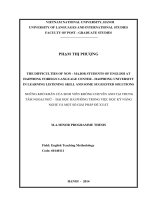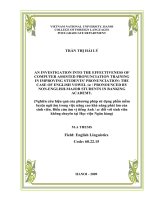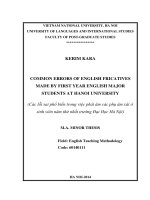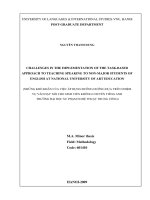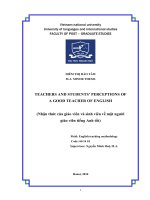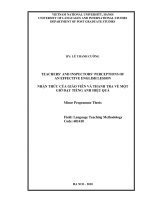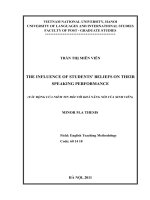Praise as classroom communicative reinforcing device perception of Haiphong University students = Nhận thức của sinh viên trường Đại học Hải Phòng về lời khen n
Bạn đang xem bản rút gọn của tài liệu. Xem và tải ngay bản đầy đủ của tài liệu tại đây (1.32 MB, 43 trang )
VIETNAM NATIONAL UNIVERSITY, HANOI
UNIVERSITY OF LANGUAGES AND INTERNATIONAL STUDIES
FACULTY OF POSTGRADUATE STUDIES
ĐỖ THỊ THÙY LINH
PRAISE AS CLASSROOM COMMUNICATIVE REINFORCING
DEVICE: PERCEPTION OF HAIPHONG UNIVERSITY STUDENTS
(Nhận thức của sinh viên trường Đại học Hải Phòng về lời khen ngợi như là
một phương tiện tăng cường giao tiếp trong lớp học)
M.A MINOR PROGRAMME THESIS
Field: English Teaching Methodology
Code: 60.14.10
HANOI - 2010
VIETNAM NATIONAL UNIVERSITY, HANOI
UNIVERSITY OF LANGUAGES AND INTERNATIONAL STUDIES
FACULTY OF POSTGRADUATE STUDIES
ĐỖ THỊ THÙY LINH
PRAISE AS CLASSROOM COMMUNICATIVE REINFORCING
DEVICE: PERCEPTION OF HAIPHONG UNIVERSITY STUDENTS
(Nhận thức của sinh viên trường Đại học Hải Phòng về lời khen ngợi như là
một phương tiện tăng cường giao tiếp trong lớp học)
M.A MINOR PROGRAMME THESIS
Field: English Teaching Methodology
Code: 60.14.10
Supervisor: Phùng Hà Thanh, M.Ed
HANOI - 2010
iv
TABLE OF CONTENTS
Page
Acknowledgements i
Declaration ii
Abstract iii
Table of contents iv
List of figures and tables vi
INTRODUCTION 1
1. Rationale of the study 1
2. Purpose of the study 2
3. Research questions 2
4. Methodology 2
5. Significance of the study 3
CHAPTER 1: LITERATURE REVIEW 4
1.1. Teacher praise: definition and functions 4
1.1.1. Definition of teacher praise 4
1.1.2. Functions of teacher praise 4
1.2. Classification of teacher praise 6
1.3. Students’ perception of teacher praise 8
1.3.1. A framework of students’ perception 8
1.3.2. Students’ perception of teacher praise 8
1.4. Resistance to teacher praise 11
1.5. Guidelines for effective teacher praise 11
CHAPTER 2: THE STUDY 15
2.1. Sampling and defining the case 15
2.2. Data collection 16
2.2.1. Instruments 16
2.2.2. Procedures 18
2.3. Data analysis 18
v
CHAPTER 3: RESULTS AND DISCUSSIONS 20
3.1. Different types of teacher praise 20
3.2. Students’ preference for different types of teacher praise 21
3.3. Students’ emotional responses to different types of teacher praise 24
3.4. Influences of different types of teacher praise on students’ self-concept 25
3.5. Influences of different types of teacher praise on students’ behaviour 25
3.6. High-achievers versus low-achievers in preference for teacher praise 26
3.7. Implications 27
CONCLUSION 31
1. Summary of the study 31
2. Limitations and future research 32
REFERENCES 33
APPENDIX I
vi
LIST OF FIGURES AND TABLES
Page
Figure 1.1: Constructs of three components of mind……………………… ………… 8
Figure 1.2: Guidelines for effective praise…………………………………………… 13
Table 2.1: Teachers’ profile…………………………………………………………… 16
Table 3.1: Means and Standard Deviation for different types of teacher praise…… …20
Table 3.2: Percentages of students’ cognition………………………………………… 22
Table 3.3: Students’ preference for different types of teacher praise……………………22
Table 3.4: High – achievers’ and low – achievers’ preference for teacher praise……….26
1
INTRODUCTION
1. Rationale of the study
It is human nature that actions bringing pleasure tend to be repeated. When a
person earns praise for having done something right, that praise acts as a reinforcer
stimulating that person to repeat the desirable behaviour. Every one of us desires praise at
some level, and in one form or another. In a working environment, being praised for
working well helps people to feel worthwhile. They will feel motivated to continue
working hard and will be encouraged to do whatever needs to be done to support the
business. In educational settings, being noticed and appreciated for their good behaviour,
students are willing to do more than they are asked, volunteer ideas and become more
involved and committed to what they are doing.
Most educational psychologists and other sources of advice to classroom teachers
stress the significance of teacher praise in communication transaction as it positively
influences students’ academic achievement (Gettinger, 1983; Luiselli & Downing, 1980),
on-task behaviour (Ferguson & Houghton, 1992; Vollmeyer & Rheinberg, 2005), pupil’s
speech (Moore, Knott & McNaughton, 1989), students’ perceptions (Baker & Graham,
1987, Stipek & MacIver, 1989) and helps to provide encouragement to students, to build
self – esteem and a close teacher-student relationship (Brophy, 1981). Indeed, it is reported
to be one of the most long – recognized and essential skill for language teacher and the
strategy teachers find easiest to employ (Munroe, 1982). Research findings tend to indicate
that the simple act of praising a student can have both reinforcing and informative
qualities.
My own thinking was no exception until one day, when I offered a student a
statement of praise, he seemed indifferent to it. His facial expression and behaviour
revealed that he did not like that praise at all. I felt quite embarrassed, and then I hooked on
research of praise right after getting home. In study after study, I find out that teacher
praise is not always beneficial; even it does more harm than good when teacher praise does
not meet student’s expectation. Such researchers as Denny (1986), Gordon (1989), Mueller
& Dweck (1998), Kamins & Dweck (1999), and Burnett (2002) argued that praise,
2
whether intended or unintended, can produce a number of negative outcomes to students’
learning environments.
Being urged by the situation, I would like to avail myself of this opportunity to
conduct a research study on students’ perception of different types of teacher praise in a
university in Vietnam to see whether it motivates or demotivates students in classroom
communication.
2. Purpose of the study
This research is designed to investigate into teacher praise and students’ perception
in a case of Haiphong University. The purposes of the study are:
+ to recognize different kinds of praise used by teachers at Haiphong Univeristy
+ to see how students at Haiphong University perceive different kinds of teacher
praise.
3. Research questions
For such purposes, the study aims at answering the following questions:
3.1. What are different types of praise that the teachers at Haiphong University offer in
classroom?
3.2. What is students’ preference for different types of teacher praise?
3.3. What are students’ emotional responses to different types of teacher praise?
3.4. To what extent is students’ self – concept influenced by different types of teacher
praise?
3.5. To what extent is students’ behaviour influenced by different types of teacher
praise?
3.6. To what extent are high – achievers different from low – achievers in terms of their
preference for different types of teacher praise?
4. Methodology
The research employed case study, using observations and semi – structured
interviews as instruments of data collection.
3
5. Significance of the study
Although studies of teacher praise are numerous in Western cultural and
educational settings, such studies of teacher praise in Vietnam are extremely scarce. The
study is undertaken to find out the teacher praise and how students perceive it in
Vietnamese context, particularly in Haiphong University. Therefore, this study contributes
to enriching the researches on this area in the context of university English classrooms in
our country. The findings and implications of this study will be of much help to both
teachers and students of English teacher training.
4
CHAPTER 1: LITERATURE REVIEW
This chapter sets out to review the literature related to teacher praise, its
functions, then discuss the classifications of teacher praise and students’ perception in
previous studies.
1.1. Teacher praise: definition and functions
1.1.1. Definition of teacher praise
The term “praise” is derived from the Latin verb “pretiare”, which means to
value highly (Burnett, 2002), and involves “commending the worth of or to express
approval or admiration” (Brophy, 1981). By definition, praise is “positive evaluation
made by a person of another’s products, performances or attributes, where the evaluator
presumes the validity of the standards on which the evaluation is based” (Kanouse,
Gumpert & Canavan – Gumpert, 1981, p. 98). This was selected in part because it is
comprehensive, and resonates well with commonsense conception of praise. According to
Hitz & Driscoll’s research on the use of teacher praise in the classroom (1989), effective
praise was thought to occur when the teacher positively acknowledged students’ work.
They pointed out that this required teachers to be non – judgemental to prevent status being
assigned to students.
1.1.2. Functions of teacher praise
There are two main functions of teacher praise: praise as reinforcement and
praise as informational feedback. Along with the development of language teaching,
different methods and approaches have emphasized on different functions of teacher
praise.
Praise as reinforcement
As a behaviorist, Skinner (1974) was forming the belief that language was learnt
through repetition and positive or negative reinforcement. Reinforcement is the process by
which the likelihood of a certain response following certain stimuli is increased. Hence, in
the time of Audio-Lingual Method, reinforcement as the extrinsic approval and praise of
the teacher or fellow student or the intrinsic self-satisfaction of target language use is a
vital element in the learning because it increases the likelihood that the behavior will occur
5
again and become a habit. When administered properly, such positive reinforcement can
successfully modify behaviour and stimulate learning.
In the educational settings, this use of praise as a positive reinforcement has been
widely recommended as a teaching strategy. Stringer & Hurt (1981, p. 1) stated that “the
communication transaction of verbal praise is an interpersonal experience and plays an
important role in the reinforce ment process, which in turn affects the learning and
behavioral activity of students.” Furthermore, Thomas (1991) referred to praise as a kind
of positive reinforcer, with consistent praise thought to encourage desirable behaviour,
while extinguished undesirable behaviour. He suggested that praise could be a
motivational tool in the classroom if reinforcement was descriptive and involved using the
students’ name, choosing appropriate praise words carefully and describing precisely the
behaviour that merits the praise. Similarly, Woolfolk (1987), quoted in Moore (2007, p.
202), discussed praise as reinforcement that teachers use a rewarding stimulus to motivate
some action or behaviour. Numerous researchers have demonstrated that teacher praise can
improve academic behaviour. Blaney (1993) investigated the effects of teacher praise on
academic achievement of elementary students, comparing groups that were taught using
high (i.e., praising correct responses, providing corrective feedback for incorrect response)
versus low (i.e., neutral feedback, such as “OK” for correct responses and “No” for
incorrect responses) levels of teacher praise. The author found that students in the groups
that received higher rates of praise for correct responding performed significantly better on
academic tests than did students who received lower praise rates for correct responding.
Praise as informational feedback
In contrast to behaviourists, constructivists in Communicative Language
Teaching (CLT) emphasize interaction as both the means and the ultimate goal of learning
a language. Therefore, the teacher acts as an advisor during communicative activity, a
facilitator of students’ learning, or a co-communicator, and helps learners in any way that
motivates them to work with the language. So, praise in this approach is regarded as both
communicative reinforcer and informational feedback.
In its essence, praise is “a form of feedback that conveys information about the
correctness or appropriateness of answers and other behaviours, as well as information
about the teacher’s positive regard for the behaviours” (Emmer, 1988, p. 32). For
6
example, a teacher praises his student with such a statement as “Wow, you’ve done great
on your presentation!”
However, it is noticeable to make a distinction between praise and feedback.
Whilst praise always provides feedback, not all feedback is praise. That is, when a teacher
gives a praise statement, he informs the student about whether his answer is favourable/
acceptable or not. On the other hand, there are many cases in which teacher feedback does
not include praise. Just by saying “okay”, “right”, “correct” or giving a letter grade or
percentage score, teachers are providing feedback. Moreover, praise is more personal than
feedback in the sense that it also expresses positive teacher emotions such as surprise,
pleasurability, excitement and admiration and/or place the student’s behaviour in context
by giving information about its value or its implication about the student’s status. Flander
(1970), cited in (Brophy, 1981), regards praise as teacher reactions that go beyond simple
feedback about appropriateness or correctness of behaviours. Sharing the same view, Blote
(1995) holds that teacher praise contains positive affect and is a more intense, detailed
response to students’ behaviour than feedback.
1.2. Classification of teacher praise
There exist many ways to classify teacher praise, among which content (what to
praise) and manner (how to praise) can be utilized as the bases for categorizing it in
educational settings. In terms of what to praise and levels of praise detail, teacher praise
can be sorted out as effort or ability praise, general or effort praise. Considering how to
praise, teacher praise can be classified as verbal or non – verbal praise. Thus, three facets
of praise are effort versus ability, general versus specific, and verbal versus non – verbal.
Effort versus ability praise
Effort, which is often used synonymously with strategy or process praise, is a
type of praise that focuses on a specific strategy the student used to complete a task. An
example of a teacher giving a student effort praise would be, “Wow! You did great! You
must have worked hard on this.” On the other hand, ability praise, which is used
synonymously with trait – oriented or person praise. “Wow! You did well on this task! You
are very smart,” would be an example of a teacher offering a student ability praise.
7
General versus specific praise
Based on the way teacher praise is administered, it is also often divided into one
of two categories, general or specific praise. The first type is the form of praising which is
directed either at no one in particular or if directed at an individual, it is generic in its use.
Some illustrations of this type are “Great job, class!” or “Well done, Jonny”. General
praise also lacks credibility because it takes no effort at all for a praiser to give a
compliment without having paid any attention to the performance of the person. In
contrast, specific praise is both directed at an individual student and very specific in what
is being praised. Considering the following statements as examples of specific praise,
“Nice job explaining absolute value, Rita” or “Amy, I really like how you used deductive
reasoning to answer that question”. It is obvious that specific praise not only lets the
student know they are correct, but it is also meaningful because it allows them to see
exactly what specific behaviour the teacher is praising and to know that the teacher has
been paying attention to their performance.
Verbal versus non – verbal praise
Coooper et al., (1994) looked at the different ways praise can be delivered,
verbally and non – verbally. Verbal praise occurs when the teacher follows a student action
or response with some type of positive comment. The common type is one – word praise or
brief phrases such as “Good,” “Excellent,”, “Correct,” or “That’s right”. Another
commonly overlooked form is the use of student ideas. This technique can be used by
applying, comparing or building on student contributions during a lesson. Incorporating
student ideas shows that what they say is important and usually increases the degree of
student participation. Non – verbal praise refers to the use of some physical action to send
a message of approval for some student action or response. The physical action can be in
the form of eye contact, a nod, a smile, a movement toward the student, a relaxed body, a
pat on the back or such positive gesture as “thumb – up” or OK sign.
Three mentioned subscales, effort versus ability praise, general versus specific
praise, and verbal versus non – verbal praise are all taken into consideration in this
research study.
8
1.3. Students’ perception of teacher praise
1.3.1. A framework of students’ perception
All three aspects of human mind, cognition, affection and conation, work together
and affect the learning process. Snow, Corno and Jackson (1996, p. 247) presented a
provisional taxonomy of individual different constructs that links cognition (procedural
and declarative knowledge), affection (temperament and emotion) and conation
(motivation and volition), as shown in the following figure:
Figure 1.1: Constructs of three components of mind
Cognition refers to the process of coming to know and understand; the process of
encoding, storing, processing and retrieving information. It is generally associated with the
question of “what”. Affection concerns about the emotional interpretation of perceptions,
information and knowledge. It is generally associated with one’s attachment, either
positive or negative, to people, objects, ideas…and asks the questions with “How do I feel
about this knowledge or information?” Conation refers to the connection of knowledge and
behaviour. It is the personal, intentional, deliberate, goad – oriented, or striving component
of motivation, the proactive aspect of behaviour. In this paper, interpretation and analysis
of students’ perception of teacher praise involves integration of thinking (cognition),
feeling (affection) and acting (conation).
1.3.2. Students’ perception of teacher praise
In a series of related studies, various researchers have to do much work to explore
how students perceive teacher praise in classrooms.
9
Regarding students’ preference for ability versus effort praise, a study performed
by Burnett in 2001 (n=747) measured Australian primary school students’ preferences for
teacher praise. Results showed that 91% of students preferred to be praised often or
sometimes while 9% said that they never wanted any praise. It was found that most
students (84%) had a preference of effort praise, rather than ability praise (16%). The
findings of Burnett suggested that if teachers meet students’ preferences for praise, they
would often give effort type. In another study conducted by Merret & Tang in 1994, 1779
British primary students were asked about their preferences for rewards, praise,
reprimands, and punishments. Again, an astounding 90% of the students preferred to
receive praise often or sometimes. These results are in line with Burnett’s mentioned
earlier.
Some psychologists (Apter, 2009) warned that praise for overall ability was
harmful because it suggested that any good performance was a result of natural ability,
which implied that a poor performance was a result of natural deficiency. Praise for an
outcome that emphasized ability then made students reluctant to take on a challenge, which
always had the possibility of failure, because it signaled lack of ability. Failures then
threatened one’s overall self – esteem. Henderlong and Lepper (2002) argued that ability
praise may have unintended consequences for motivation, performance, and determination,
especially when students experience continuous setbacks in the areas in which they were
praised. In six studies, Mueller and Dweck (1998) looked at the effects of praising for
ability and effects of praising for effort on fifth – grade students and how they handled
these types of praise under conditions of failure and conditions of success. Their overall
conclusion is that it can be problematic to praise students in terms of their ability or
intelligence rather than their hard work or effort. However, on the basis of self – efficacy
theory, Schunk (1984) reasoned that ability praise should produce higher expectations for
future performance than effort praise because of the stronger competence information,
particularly for children in the early stages of learning a new task.
With respect to gender differences, Koestner, Zuckerman, and Koestner (1989)
argued that, in success situation, boys may be comfortable with ability praise, whereas
girls may be more comfortable with effort praise. They included that perceptions of
competence, performance and intrinsic motivation were all enhanced for boys when ability
praise was given, and the same were enhanced for girls when effort praise was given.
10
Concerning the impacts of specific and general teacher praise on students’
perception, Burke, cited in Loo (2009), found that giving specific praise reinforced good
behaviour in a way that general praise could not. In adults, the act of giving a general
praise is often dismissed as being insincere because it alludes to the fact that the person
was not really noticing in the first place. He found that people associated general praise as
just a formality of communication, to make the other person sound caring, but nothing
more than that. He concluded that if we could make our praise much more specific towards
the behaviour that warranted the praise to begin with, then the effects of that praise would
be felt by the individual and taken as genuine. The result in Burnett’s study (2002) also
indicated that general teacher praise was not related to students’ perception of the
classroom environment or their relationship with their teachers. He believed that whilst
general praise did not affect students’ perception, the specific types of praise did.
As regards to verbal and non – verbal praise, some researches claimed that
verbal praise, when used correctly, can enhance the learning process. In two separate
studies, Hancock (2000, 2002) found that undergraduate and graduate students who were
exposed to verbal praise reported that they studied significantly more outside the
classroom than students who were not exposed to verbal praise. He believed that verbal
praise is an important mediator in the enhancement of students’ motivation to learn.
However, other researchers have argued that verbal praise can have potential negative
consequences. They have wrapped up that not all students prefer to be praised verbally. For
example, Elwell & Tiberio (1994) realized that while adolescents perceive praise to be
important to academic achievement, they do not want to be praised verbally in front of
their classmates. It may be even more powerful than verbal praise. Research suggests that
when verbal and non – verbal messages differ, students tend to respond to the non – verbal
message. (Moore, 2007, p. 204)
The results of the previously described studies suggest that different types of
teacher praise is perceived differently by different groups of people. It is also
recommended as a powerful tool in the classroom for producing desirable academic
responding. As such, one might expect that teachers use praise effectively as part of their
teaching repertoire.
11
1.4. Resistance to teacher praise
Whereas the empirical literature has demonstrated the positive effects of teacher
praise, there are some opposing the use of praise in the educational settings. Most of those
are individuals who believe that learning is intrinsically worthwhile and rewarding, at least
when learners are allowed to follow their own interests at their own pace (Montessori,
1964). They consider all elements to control through extrinsic reinforcement as
unnecessary, intrusive and perhaps harmful. Farson (1968) stated that it was questionable
as a motivator since verbal praise was an evaluation, and judgement of any kind which
causes people to feel uncomfortable. Farson labeled praise as “a piece of psychological
candy” and contends that rather than being a reward, praise is in fact a threat, because of
the user’s intent to motivate, move, or change the recipient (cited in Stringer, B. and Hurt,
T. (1981)). Similarly, some teachers avoid praise because they want to train their students
to think for themselves rather than depend on the teachers for guidance.
Other arguments against using praise for improving achievement were put forth by
Rowe (1974). Through her three observations, she noticed that praise inhibited the verbal
performance of her students, lowered the number of alternative explanations offered by her
students, and apparently undermined their confidence in their answers. Praise also fostered
competition and therefore cut down on cooperation and exchange of ideas among the
students. And finally verbal praise cut into the students’ task persistence. It is apparent that
the fact that praise can function as a reinforcer does not necessarily mean that it always or
even usually does (Brophy, 1981).
1.5. Guidelines for effective teacher praise
Teacher praise has long been an educational concern. Although researchers hold
different points of view about praise, the author still recognizes that qualified teacher
praise can best reinforce students’ academic and behavioural performance.
Quality of teacher praise
O’Leary and O’Leary (1977) indicated that effective teacher praise as
reinforcement must have the following qualities:
12
- contingency: the praise must be contingent on performance of the behaviour to be
reinforced
- specificity: the praise should specify the particulars of the behaviour being reinforced
- sincerity/ variety/ credibility: the praise should be sincere. Among other things, this
means that the content will be varied according to the situation and the preferences of
the student being praised.
Other guidelines for praising effectively were given by Brophy (1981, p. 26) as
follows:
13
Effective Praise
Ineffective Praise
1. Is delivered contingently
2. Specifies the particulars of the accomplishment
3. Shows spontaneity, variety and other signs of credibility;
suggests clear attention to the student’s accomplishment
4. Rewards attainment of specified performance criteria
(which can include effort criteria, however)
5. Provides information to students about their competence or
the value of their accomplishments
6. Orients students toward better appreciation of their own task
– related behaviour and thinking about problem solving
7. Uses student’s own prior accomplishments as the context
for describing present accomplishments
8. Is given in recognition of noteworthy effort or success at
difficult (for this student) tasks
9. Attributes success to effort and ability, implying that similar
success can be expected in the future
10. Fosters endogenous attributions (students believe that they
expend effort on the task because they enjoy the task and/or
want to develop task – relevant skills)
11. Focuses students’ attention on their own task – relevant
behaviour
12. Fosters appreciation of, and desirable attribution about, task
– relevant behaviour after the process is completed.
1. Is delivered randomly or unsystematically
2. Is restricted to global positive reactions
3. Shows a bland uniformity that suggests a conditioned response
made with minimal attention
4. Rewards mere participation, without consideration of
performance processes or outcomes
5. Provides no information at all or gives students information
about their status relative to peers
6. Orients students towards comparing themselves with others and
thinking about competing
7. Uses the accomplishments of peers as the context for describing
student’s present accomplishments
8. Is given without regard to the effort expended or the meaning of
the accomplishment (for this student)
9. Attributes success to ability alone or to external factors such as
luck or (easy) task difficulty
10. Fosters exogenous attributions (students believe that they expend
effort on the task for external reasons – to please the teacher, win
a competition or reward, etc.)
11. Focuses students’ attention on the teacher as an external
authority figure who is manipulating them
12. Intrudes into the ongoing process, distracting attention from task
– relevant behaviour
Figure 1.2: Guidelines for Effective Praise
14
Summary
In a nutshell, teacher praise is the act of teachers’ expressing approval,
commendation or admiration of students’ behaviour in class. It is preferred to be a
communicative reinforcer and informational feedback, which is more personal to
encourage students’ self – awareness, self – responsibility, greater internal motivation and
better self – concept. Praise is an important and powerful tool for teachers, but it is difficult
to use correctly. As evidenced in previous research, there are different learning outcomes
that result from different types of praise. However, one of the concerns with those
researches is that much of the literature on praise is focused on young children. Little is
known about praise with student populations beyond the high school level elsewhere in the
world, let alone in Vietnam’s context. Therefore, it is significant to identify how university
students perceive praise so that researchers can find ways to improve learning outcomes
for this population. The next chapter is designed to present about the method, participants
and procedure of the study.
15
CHAPTER 2: THE STUDY
This research studied a group of students’ perception of different types of teacher
praise in Foreign Language Department, Haiphong University. Five teachers teaching this
group were also the subjects of the research. In this case study, the way teachers delivered
praise in the classroom was recorded and the praised students were interviewed to see how
they perceived their teacher praise. Descriptive statistics was employed to analyze the
collected data.
2.1. Sampling and defining the case
Defining the case
There were some criteria for this purposive sampling. The first criterion was a
mixed ability class, which has both high – achievers and low – achievers. The second was
that the students specialize in English language teaching, for the researcher intended to
expand the findings and implications for their future career. Last but not least, the
participants were selected based on accessibility and willingness to take part in the study.
A case that satisfied these selection criteria was a class of 50 English language
teaching students K9 in Foreign Language Department, Haiphong University. The age of
students ranges from 19 to 23, 92% being 20 or 21 years old. This group comprises 12%
boys and 88% girls. They come from different districts of Haiphong city, 46% in urban
areas and 54% in rural areas. They had studied English for seven years in secondary and
high schools, and for two years as university students. Basing on GPA for the first two
years at university, 22% of the students were evaluated “very good”, 48% “good” and 30%
“weak”. Since they are the third year students, they are used to the ritual language teaching
in the department and familiar with the teaching style of their teachers. In class, the
students are quite active and cooperative with their classmates and teachers.
Teachers
In this research, two female and three male teachers who teach third – year
students of English language teaching in Foreign Language Department, Haiphong
University were involved. There is an American teacher, from Eli group (a non –
governmental organization providing volunteer teachers for African and Asian areas,
Vietnam included) and other four Vietnamese teachers. They are all aged from 30 to 47.
16
They have a minimum of five years of foreign language teaching experience and a
maximum of 15 years. Four of them hold an M.A degree. In the following table, they are
represented under pseudonyms as A, B, C, D and E respectively.
Teachers’ profile
No.
Name
Gender
Age
Degree
Years of teaching
experience
Subject/ Course
name
1
A
Male
47
B.A
9
British studies
2
B
Female
36
M.A
12
Grammar
3
C
Male
38
M.A
15
English Teaching
Methodology
4
D
Female
30
M.A
5
Phonetics and
Phonology
5
E
Male
32
M.A
7
Semantics
Table 2.1: Teachers’ profile
Students
After classroom observation sessions, the total number of the praised students
was 30. They were treated as the subjects of the interviews. Four of them (13.33%) were
male and twenty – six (86.67%) were female. These students could be divided into two
groups: high – achievers (63.33%) and low – achievers (36.67%).
2.2. Data collection
2.2.1. Instruments
As the present study attempted to find out kinds of teacher praise and students’
perception of those praises when teachers gave lectures to English majors in classroom
setting, as a result, a case study was utilized. The reason for choosing the case study was
that classroom was a special and restricted setting. It was impossible to control all the
variables that might influence the outcome in a large – scale study, as Mertens (1998, p.
145) pointed out, “single case research is particularly appealing because it is based on an
interest in the effectiveness of an intervention for a single, particular individual”. In this
sense, this research is naturalistic in nature. Hence, a research method called “naturalistic
17
inquiring” (Allwright & Bailey, 1991) is adopted to investigate what is really going on in
foreign language classroom. “Naturalistic inquiry” refers to that the researcher tries not to
intervene in the research setting and does not try to control naturally occurring events,
because the researcher wishes to describe and understand the process rather than to test
specific hypotheses about cause – and – effect relationship. Therefore, naturalistic inquiry
is holistic, heuristic and low in control.
In order to obtain the data, classroom observation and semi – structured interview
were the main devices in this study.
Classroom observation
This is a method of measuring classroom behaviours from direct observations that
specifies the behaviours that are to be observed and the frequency with which they are
occurred in the classroom. This method permit researchers to study the processes of
education in naturalistic settings, provide more detailed and precise evidence than other
data sources and supplies a coherent, well – substantiated knowledge base to improve
understanding and better models for improving teaching. During classroom observation,
the researcher observed and noted down the teaching sequence with the use of an
observation form which was created on the basis of what and how to praise. By means of
this form (see Appendix), names of the students who teachers gave praise were singled out.
After the class, data were examined with regard to the first research question which the
study set out to address.
Semi-structured interview
In order to give insights into the students’ perception of teacher praise, semi –
structured interviews were conducted with praised students. The choice of semi –
structured rather than structured interview was employed because it offered sufficient
flexibility to approach different respondents differently while still covering the same areas
of data collection. It started trying to minimize the hierarchical situation in order that the
subject felt comfortable talking with the interviewer. Then, the questions for interview
tended to be asked in a similar order and format to make a form of comparison between
answers possible. However, there was also scope for pursuing and probing for novel,
relevant information through additional questions that the interviewer posed during the
process. Usually the interviewer’s role was to engage, encourage and facilitate the
18
interviewees to talk about their views and experiences in depth but with limited reciprocal
engagement. After each observation session, the students who earned teacher praise were
asked for the semi – structured interviews with the question design based on the framework
of students’ perception, specifically their cognitive (self – awareness), affective
(preference) and conative (motivation to study) (see Appendix). All of the interviews were
analyzed for data analysis process to find out the answers to the last five research
questions.
2.2.2. Procedures
The duration of the observation period for data collection was 5 weeks. Data were
collected in each of 5 lecturers, resulting in a total of 25 class visits. The subject matters
being taught during observations included Grammar, Methodology, Phonetics and
Phonology, Semantics, and British studies. Classroom activities were lecture – giving,
tutorials, exercise – checking and students’ presentation. They also ranged from individual
seat work to entire class oral discourse. Each observation session lasted 45 minutes. During
observation procedure, the researcher noted the names of the students who received teacher
praise, the statements of teacher praise and any other accompanying factors. After each
observation session, these students were asked to join in semi – structured interviews with
10 prepared questions. Each interview lasted 15 to 20 minutes. They were conducted in a
friendly atmosphere in the teaching staff’s office. The researcher took detailed notes during
the interviews. Taken as a whole, a total of 30 students partook in the interviews revealing
their awareness of the teacher praise (Question 1 & 2), their overall feeling when they
earned teacher praise (Question 3 & 4), their preference to the way teacher praised
(Questions 5, 6 & 7), their self – concept (Question 8) and their behaviour after receiving
teacher praise (Questions 9 & 10).
Then, the two sources of information were studied correlatively so that we could
get a thorough understanding of the students’ perception of teacher praise.
2.3. Data analysis
Based on the notes from observation forms, the answer to the first research
question was found out (with the number of occurrence, mean and standard deviation), and
19
the students for semi – structured interviews were selected. Then, the results of the
interviews were categorized according to five research questions, using descriptive
statistics. Quantitative method (figures in numbers and percentages) and qualitative
method (teacher praise statements and students’ opinions) were both adopted to analyze the
collected data.
Summary
The author has strong interest in discovering the teacher praise types and the
influences they have upon students’ perception in the classrooms. Thus in this paper, a case
study was exploited with purposive sampling of English language teaching students K9 in
Foreign Language Department, Haiphong University . The devices of data collection were
classroom observations and semi – structured interviews, with a detailed description of the
procedure. The way to analyze the data was also presented. The next chapter is about to
interpret the results of the study.
20
CHAPTER 3: RESULTS AND DISCUSSIONS
The research was conducted in five weeks to investigate how students perceive
different types of teacher praise. This chapter showed the results of all data gathered
throughout the research. The information reported here was derived from quantitative and
qualitative methods. Then, the findings and implications were stated.
3.1. Different types of teacher praise
The observations aimed at exploring the types of praise that teachers administered
in the classroom. Following the data collection, the data obtained were simplified for
analysis. For each teacher, 5 visits during 5 weeks were combined, providing the time that
teacher praise occurred was a 225-minute period.
The total number of praise given was 30, among which mean frequencies were
computed for each type of praise as follows:
No.
Type of praise
Times of occurrence (N)
Mean (M)
Standard Deviation (SD)
1
Effort
10
2.0
0.71
2
Ability
5
1.0
1.22
3
Specific
10
2.0
1.0
4
General
20
4.0
2.0
5
Verbal
28
5.6
2.3
6
Non-verbal
14
2.8
1.92
Table 3.1: Means and Standard Deviation for different Types of Teacher Praise
As can be seen from the table, little difference was found for the times of
occurrence between effort praise and ability praise. However, there were statistically
significant differences in the appearance of specific versus general praise, verbal versus
non – verbal praise.
The data revealed that effort praise was delivered when the teachers appreciated
students for their successful or brave attempt, hard work, and their applying of appropriate
strategies to fulfill the tasks. Take these as illustrations: “You must have tried really hard”,
“That was hard for you, but you kept going on”, “You are finding really good ways to deal
with classroom management”. Meanwhile ability praise focused on intelligence or
competence of the students, such as “Very smart!”, “That’s good! I can see that your
